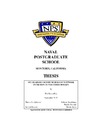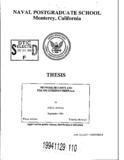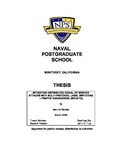Multi-armed bandit models of network intrusion in the cyber domain

Download
Author
Kronzilber, Dor
Date
2017-09Advisor
Szechtman, Roberto
Yoshida, Ruriko
Second Reader
Kress, Moshe
Metadata
Show full item recordAbstract
We model attacks against computer networks in the cyber domain from the attacker’s point of view. We consider an attacker with
limited resources and time, whose goal is to maximize the expected reward earned by exploiting infected computers, while considering
the risks. A computer network is represented as a graph consisting of computers or routers, where each computer has unknown
expected reward and the routers connect sub-networks of computers. At time zero the attacker starts from an infected computer, called
the “home computer,” while all the other computers in the network are not infected. In any given period, the attacker can try to earn
a reward by exploiting the subset of infected computers, or can choose to expand by infecting adjacent computers and routers, which
does not accrue any reward. However, each infected computer must be connected through other infected computers all the way to the
“home computer” for the attacker to be able to exploit it (but this connectivity may be lost when attacks are detected). For the linear
network model, which is a worst-case scenario from the attacker point of view, we find that the optimal number of nodes to attempt to
infect is of the order square root of the time when the network is sufficiently large. Also, we determine a critical relationship between
the attacker’s probability to infect a new node and the probability of detection. When this critical condition is met, the attacker should
not try to infect any additional nodes.
Rights
Copyright is reserved by the copyright owner.Collections
Related items
Showing items related by title, author, creator and subject.
-
MULTI-ARMED BANDIT MODELS FOR EXPLOITATION OF CYBER NETWORKS
Chan, Baixian Alvin (Monterey, CA; Naval Postgraduate School, 2021-09);Computer networks are often the target of cyber attacks carried out by malevolent agents, to either disable critical system operations or to surreptitiously gain access to sensitive data. The asymmetric and covert nature ... -
Network security and the NPS Internet firewall
Schively, Jody L. (Monterey, California. Naval Postgraduate School, 1994-09);As the Naval Postgraduate School's (NPS) computer network continues to incorporate computers with a wide variety of security holes, it is vital that an Internet firewall be installed to provide perimeter security for NPS ... -
Mitigating distributed denial of service attacks with Multiprotocol Label Switching--Traffic Engineering (MPLS-TE)
Vordos, Ioannis (Monterey, California. Naval Postgraduate School, 2009-03);A Denial of Service (DoS) occurs when legitimate users are prevented from using a service over a computer network. A Distributed Denial of Service (DDoS) attack is a more serious form of DoS in which an attacker uses the ...


 17Sep_Kronzilber_Dor.pdf (1.148Mb)
17Sep_Kronzilber_Dor.pdf (1.148Mb)

